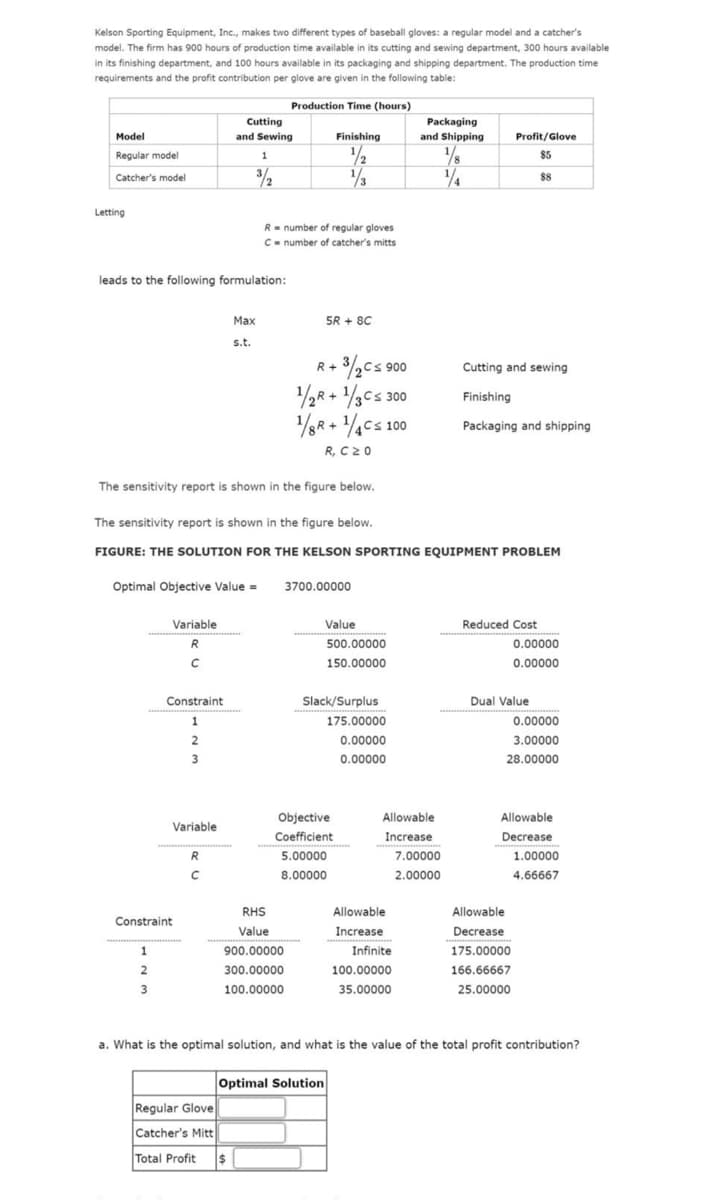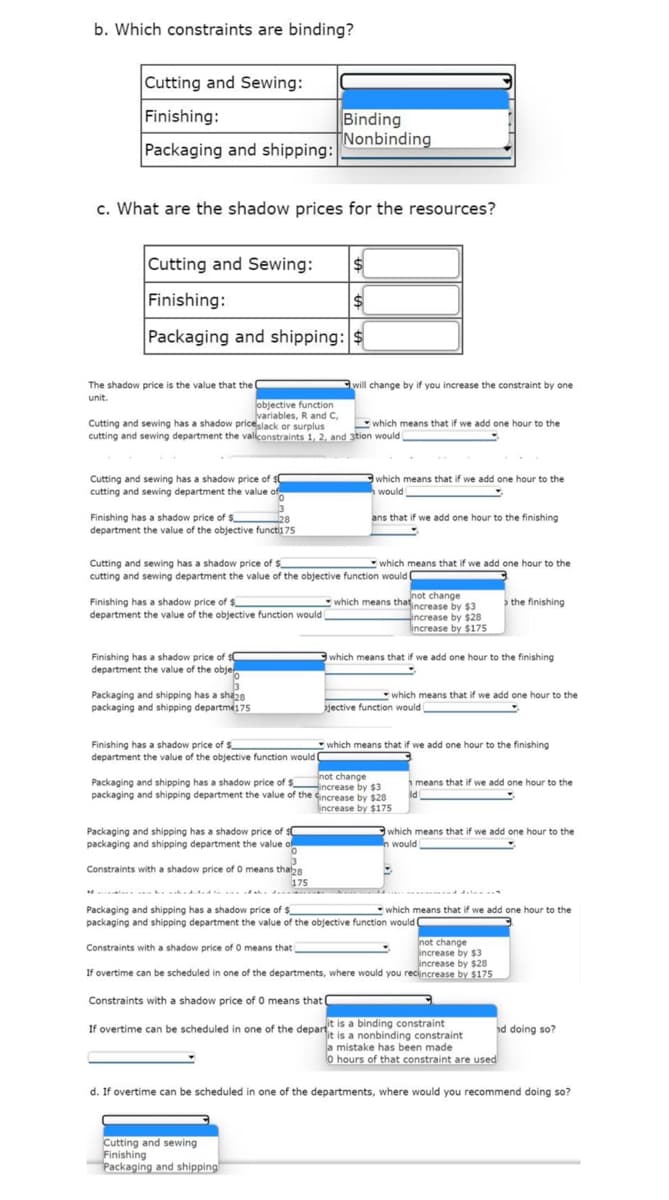Kelson Sporting Equipment, Inc., makes two different types of baseball gloves: a regular model and a catcher's model. The firm has 900 hours of production time available in its cutting and sewing department, 300 hours available in its finishing department, and 100 hours available in its packaging and shipping department. The production time requirements and the profit contribution per glove are given in the following table: Production Time (hours) Model Regular model Catcher's model Letting leads to the following formulation: Constraint 1 2 Optimal Objective Value = 3 Variable R с с Constraint 1 The sensitivity report is shown in the figure below. 2 Cutting and Sewing 3 1 3/2 Variable The sensitivity report is shown in the figure below. FIGURE: THE SOLUTION FOR THE KELSON SPORTING EQUIPMENT PROBLEM R с Max s.t. R number of regular gloves C number of catcher's mitts = Regular Glove Catcher's Mitt Total Profit $ Finishing 1/2 ¹/3 5R + 8C 3/2C≤ 900 1/2+1/3Cs 300 1/8R+ ¹/4 Cs 100 R, C20 RHS Value 900.00000 300.00000 100.00000 3700.00000 Objective Coefficient 5.00000 8.00000 Optimal Solution Value 500.00000 150.00000 Slack/Surplus 175.00000 0.00000 0.00000 Packaging and Shipping 1/8 14 Allowable Increase Allowable Increase Infinite 100.00000 35.00000 7.00000 2.00000 Profit/Glove $5 88 Cutting and sewing Finishing Packaging and shipping Reduced Cost 0.00000 0.00000 Dual Value 0.00000 3.00000 28.00000 Allowable Decrease 175.00000 166.66667 25.00000 Allowable Decrease a. What is the optimal solution, and what is the value of the total profit contribution? 1.00000 4.66667
Kelson Sporting Equipment, Inc., makes two different types of baseball gloves: a regular model and a catcher's model. The firm has 900 hours of production time available in its cutting and sewing department, 300 hours available in its finishing department, and 100 hours available in its packaging and shipping department. The production time requirements and the profit contribution per glove are given in the following table: Production Time (hours) Model Regular model Catcher's model Letting leads to the following formulation: Constraint 1 2 Optimal Objective Value = 3 Variable R с с Constraint 1 The sensitivity report is shown in the figure below. 2 Cutting and Sewing 3 1 3/2 Variable The sensitivity report is shown in the figure below. FIGURE: THE SOLUTION FOR THE KELSON SPORTING EQUIPMENT PROBLEM R с Max s.t. R number of regular gloves C number of catcher's mitts = Regular Glove Catcher's Mitt Total Profit $ Finishing 1/2 ¹/3 5R + 8C 3/2C≤ 900 1/2+1/3Cs 300 1/8R+ ¹/4 Cs 100 R, C20 RHS Value 900.00000 300.00000 100.00000 3700.00000 Objective Coefficient 5.00000 8.00000 Optimal Solution Value 500.00000 150.00000 Slack/Surplus 175.00000 0.00000 0.00000 Packaging and Shipping 1/8 14 Allowable Increase Allowable Increase Infinite 100.00000 35.00000 7.00000 2.00000 Profit/Glove $5 88 Cutting and sewing Finishing Packaging and shipping Reduced Cost 0.00000 0.00000 Dual Value 0.00000 3.00000 28.00000 Allowable Decrease 175.00000 166.66667 25.00000 Allowable Decrease a. What is the optimal solution, and what is the value of the total profit contribution? 1.00000 4.66667
Practical Management Science
6th Edition
ISBN:9781337406659
Author:WINSTON, Wayne L.
Publisher:WINSTON, Wayne L.
Chapter4: Linear Programming Models
Section: Chapter Questions
Problem 107P
Related questions
Question

Transcribed Image Text:Kelson Sporting Equipment, Inc., makes two different types of baseball gloves: a regular model and a catcher's
model. The firm has 900 hours of production time available in its cutting and sewing department, 300 hours available
in its finishing department, and 100 hours available in its packaging and shipping department. The production time
requirements and the profit contribution per glove are given in the following table:
Model
Regular model
Catcher's model
Letting
leads to the following formulation:
Variable
R
C
1
2
3
Optimal Objective Value =
Constraint
1
2
3
Variable
Constraint
Cutting
and Sewing
1
3/2
R
с
с
Max
s.t.
The sensitivity report is shown in the figure below.
Regular Glove
Catcher's Mitt
Total Profit
Production Time (hours)
R number of regular gloves
C = number of catcher's mitts
The sensitivity report is shown in the figure below.
FIGURE: THE SOLUTION FOR THE KELSON SPORTING EQUIPMENT PROBLEM
Finishing
1/2
1/3
RHS
Value
900.00000
300.00000
100.00000
SR + 8C
+ ³/₂2 C≤ 900
1/2R + ¹/3C≤ 300
1/8R+ 1/4Cs 100
R, C20
R+
3700.00000
Value
Optimal Solution
500.00000
150.00000
Slack/Surplus
Objective
Coefficient
5.00000
8.00000
175.00000
0.00000
0.00000
Packaging
and Shipping
1/8
14
Allowable
Increase
Allowable
Increase.
Infinite
100.00000
35.00000
7.00000
2.00000
Profit/Glove
$5
$8
Cutting and sewing
Finishing
Packaging and shipping
Reduced Cost
0.00000
0.00000
Dual Value
0.00000
3.00000
28.00000
Allowable
Decrease
175.00000
166.66667
25.00000
Allowable
Decrease
a. What is the optimal solution, and what is the value of the total profit contribution?
1.00000
4.66667

Transcribed Image Text:b. Which constraints are binding?
Cutting and Sewing:
Finishing:
Packaging and shipping:
c. What are the shadow prices for the resources?
Cutting and Sewing:
Finishing:
Packaging and shipping: $
The shadow price is the value that the
unit.
Cutting and sewing has a shadow price of $0
cutting and sewing department the value of
objective function
variables, R and C,
Cutting and sewing has a shadow price slack or surplus
cutting and sewing department the valiconstraints 1, 2, and 3tion would
Finishing has a shadow price of $
department the value of the objective functi175
28
Finishing has a shadow price of $
department the value of the objective function would
Finishing has a shadow price of $
department the value of the obje
0
3
Packaging and shipping has a sha28
packaging and shipping departme175
Binding
Nonbinding
Cutting and sewing has a shadow price of $
cutting and sewing department the value of the objective function would
Finishing has a shadow price of $
department the value of the objective function would
Packaging and shipping has a shadow price of $C
packaging and shipping department the value.
0
will change by if you increase the constraint by one
Constraints with a shadow price of O means tha28
175
which means that if we add one hour to the
which means that if we add one hour to the
would
ans that if we add one hour to the finishing
which means that if we add one hour to the
Cutting and sewing
Finishing
Packaging and shipping
not change
which means that increase by $3
increase by $28
increase by $175
which means that if we add one hour to the finishing
not change
increase by $3
Packaging and shipping has a shadow price of $
packaging and shipping department the value of the increase by $28
increase by $175
which means that if we add one hour to the
jective function would
which means that if we add one hour to the finishing
the finishing
means that if we add one hour to the
ld
which means that if we add one hour to the
In would
Packaging and shipping has a shadow price of $
which means that if we add one hour to the
packaging and shipping department the value of the objective function would (
Constraints with a shadow price of O means that
not change
increase by $3
increase by $28
If overtime can be scheduled in one of the departments, where would you recincrease by $175
Constraints with a shadow price of O means that I
If overtime can be scheduled in one of the departit is a binding constraint
it is a nonbinding constraint
nd doing so?
a mistake has been made
o hours of that constraint are used
d. If overtime can be scheduled in one of the departments, where would you recommend doing so?
Expert Solution
This question has been solved!
Explore an expertly crafted, step-by-step solution for a thorough understanding of key concepts.
This is a popular solution!
Trending now
This is a popular solution!
Step by step
Solved in 2 steps with 1 images

Recommended textbooks for you

Practical Management Science
Operations Management
ISBN:
9781337406659
Author:
WINSTON, Wayne L.
Publisher:
Cengage,

Practical Management Science
Operations Management
ISBN:
9781337406659
Author:
WINSTON, Wayne L.
Publisher:
Cengage,